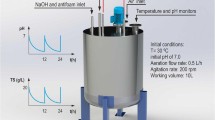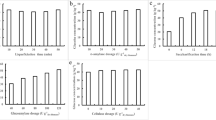Abstract
In this study, probiotic biomass and nisin productions by Lactococcus lactis CECT 539 were followed in two realkalized fed-batch cultures in diluted whey (DW) supplemented with KH2PO4 up to a total phosphorus concentration of 0.459 g/L. Increased biomass (5.12 g/L, 2.18 × 1010 CFU/mL) and nisin (235.23 BU/mL) concentrations were obtained in the culture fed concentrated whey and concentrated mussel processing waste (CMPW) medium supplemented with glucose up to a concentration of 400 g/L (CMPW + G medium) compared with similar fed-batch fermentations in DW medium. In the second fed-batch fermentation, the feeding medium CMPW + G was supplemented with KH2PO4 up to a TP concentration of 3.21 g/L. With this approach, increased production of biomass (5.49 g/L, 2.33 × 1010 CFU/mL) and nisin (257.59 BU/mL) was obtained. Considering the substantial availability of these wastes at very low prices from local dairy and mussel processing plants in Galicia, their use as culture media could offer an attractive alternative for a low-cost production of probiotic biomass and nisin at a high scale.






Similar content being viewed by others
Abbreviations
- DW:
-
Diluted whey medium
- CW:
-
Concentrated whey medium
- MPW:
-
Mussel processing waste medium
- CMPW:
-
Concentrated mussel processing waste medium
- CG:
-
400 g/L concentrated glucose
- CMPW + G:
-
Concentrated mussel processing waste medium supplemented with glucose up to a concentration of 400 g/L
- TS:
-
Total sugars concentration
- TP:
-
Total phosphorus concentration
- CMPWCW-I:
-
Realkalized fed-batch fermentation in DW medium containing 0.459 g TP/L with feeding with a mixture of CW and CMPW + G medium
- CMPWCW-II:
-
Realkalized fed-batch fermentation in DW medium containing 0.459 g TP/L with feeding with a mixture of CW and CMPW + G medium supplemented with KH2PO4 to obtain the same C/P relationship noted in the MRS medium
- CDW:
-
Cell dry weight concentration (g/L)
- LA:
-
Lactic acid concentration (g/L)
- AA:
-
Acetic acid concentration (g/L)
- B:
-
Butane-2,3-diol concentration (g/L)
- G:
-
Glucose concentration (g/L)
- L:
-
Lactose concentration (g/L)
- Pr:
-
Protein concentration (g/L)
- TN:
-
Total nitrogen concentration (g/L)
- TP:
-
Total phosphorus concentration (g/L)
- Nis:
-
Nisin concentration (BU/mL or IU/mL)
- VCC:
-
Viable cell count (CFU/mL)
- P CDW :
-
Cell dry weight productivity (g/L/h)
- P Nis :
-
Nisin productivity (BU/mL/h)
- P LA :
-
Lactic acid productivity (g/L/h)
- P AA :
-
Acetic acid productivity (g/L/h)
- P B :
-
Butane-2,3-diol productivity (g/L/h)
- Y Nis/CDW :
-
Yield of nisin on cell dry weight (BU/mg)
- Y CDW/TSc :
-
Yield of cell dry weight on total sugars consumed (g/g)
- Y Nis/TSc :
-
Yield of nisin on total sugars consumed (BU/mg)
- Y CDW/TNc :
-
Yield of cell dry weight on total nitrogen consumed (g/g)
- Y Nis/TNc :
-
Yield of nisin on total nitrogen consumed (BU/mg)
- E L :
-
Efficiency in lactose consumption (g lactose consumed/g lactose supplied)
- E G :
-
Efficiency in glucose consumption (g glucose consumed/g glucose supplied)
- E TN :
-
Efficiency in total nitrogen consumption (g TN consumed/g TN supplied)
- E TP :
-
Efficiency in total phosphorus consumption (g TP consumed/g TP supplied)
References
Anadón A, Martínez MR, Aranzazu M (2006) Probiotics for animal nutrition in the European Union. Regulation and safety assessment. Regul Toxicol Pharmacol 45:91–95
Cabo ML, Murado MA, González MP, Pastoriza L (2001) Effects of aeration and pH gradient on nisin production. A mathematical model. Enzyme Microb Technol 29:264–273
Cocaign-Bousquet M, Garrigues C, Loubiere P, Lindley ND (1996) Physiology of pyruvate metabolism in Lactococcus lactis. Antonie Van Leeuwenhoek 70:253–267
Collins LB, Thomas TD (1974) Pyruvate kinase of Streptococcus lactis. J Bacteriol 120:52–58
Costas M, Alonso E, Guerra NP (2016) Nisin production in realkalized fed-batch cultures in whey with feeding with lactose- or glucose-containing substrates. Appl Microbiol Biotechnol 100:7899–7908
Costas M, Alonso E, Outeiriño D, Fajardo P, Guerra NP (2017) Combination of food wastes for an efficient production of nisin in realkalized fed-batch cultures. Biochem Eng J 123:13–23
De Vuyst L, Vandamme EJ (1993) Influence of the phosphorus and nitrogen source on nisin production in Lactococcus lactis subsp. lactis batch fermentations using a complex medium. Appl Microbiol Biotechnol 40:17–22
Fajardo P, Fuciños C, Méndez J, Pastrana L, Guerra NP (2008) Performance and intestinal coliform counts in weaned piglets fed a probiotic culture (Lactobacillus casei subsp. casei CECT 4043) or an antibiotic. J Food Prot 71:1797–1805
Garrigues C, Loubiere P, Lindley ND, Cocaign-Bousquet M (1997) Control of the shift from homolactic acid to mixed-acid fermentation in Lactococcus lactis: predominant role of the NADH/NAD+ ratio. J Bacteriol 179:5282–5287
Goel A, Santos F, de Vos WM, Teusink B, Molenaar D (2012) Standardized assay medium to measure Lactococcus lactis enzyme activities while mimicking intracellular conditions. Appl Environ Microbiol 78:134–143
Guerra NP (2014) Modeling the batch bacteriocin production system by lactic acid bacteria by using modified three-dimensional Lotka–Volterra equations. Biochem Eng J 88:115–130
Guerra NP, Pastrana L (2002) Modelling the influence of pH on the kinetics of both nisin and pediocin production and characterization of their functional properties. Proc Biochem 37:1005–1015
Guerra NP, Pastrana L (2003) Enhancement of nisin production by Lactococcus lactis in periodically re-alkalized cultures. Biotechnol Appl Biochem 38:157–167
Guerra NP, Rua ML, Pastrana L (2001) Nutritional factors affecting the production of two bacteriocins from lactic acid bacteria on whey. Int J Food Microbiol 70:267–281
Guerra NP, Fajardo P, Méndez J, Cachaldora P, Pastrana L (2007a) Production of four potentially probiotic lactic acid bacteria and their evaluation as feed additives for weaned piglets. Anim Feed Sci Technol 134:89–107
Guerra NP, Torrado A, López C, Fajardo P, Pastrana L (2007b) Dynamic mathematical models to describe the growth and nisin production by Lactococcus lactis subsp. lactis CECT 539 in both batch and re-alkalized fed-batch cultures. J Food Eng 82:103–113
Landers TF, Cohen B, Wittum TE, Larson EL (2012) A review of antibiotic use in food animals: perspective, policy, and potential. Public Health Rep 127:4–22
Levering J, Musters MWJM, Bekker M, Bellomo D, Fiedler T, de Vos WM, Hugenholtz J, Kreikemeyer B, Kummer U, Teusink B (2012) Role of phosphate in the central metabolism of two lactic acid bacteria—a comparative systems biology approach. FEBS J 279:1274–1290
Lv W, Cong W, Cai Z (2005) Effect of sucrose on nisin production in batch and fed-batch culture by Lactococcus lactis. J Chem Technol Biotechnol 80:511–514
Matijašić BB, Stojkovic S, Salobir J, Malovrh S, Rogelj I (2004) Evaluation of the Lactobacillus gasseri K7 and LF221 strains in weaned piglets for their possible probiotic use and their detection in the faeces. Anim Res 53:35–44
Murado MA, Siso MIG, González MP, Montemayor MI, Pastrana L, Pintado J (1993) Characterization of microbial biomasses and amylolytic preparations obtained from mussel processing waste treatment. Bioresour Technol 43:117–125
Murado MA, González MP, Vázquez JA (2002) Dose-response relationships: an overview, a generative model and its application to the verification of descriptive models. Enzyme Microb Technol 31:439–455
Papagianni M, Avramidis N, Filiousis G (2007a) Glycolysis and the regulation of glucose transport in Lactococcus lactis spp. lactis in batch and fed-batch culture. Microb Cell Fact 6:16
Papagianni M, Avramidis N, Filiousis G (2007b) Investigating the relationship between the specific glucose uptake rate and nisin production in aerobic batch and fed-batch glucostat cultures of Lactococcus lactis. Enzyme Microb Technol 40:1557–1563
Pascual M, Hugas M, Badiola JI, Monfort JM, Garriga M (1999) Lactobacillus salivarius CTC2197 prevents Salmonella enteritidis colonization in chickens. Appl Environ Microbiol 65:4981–4986
Pongtharangkul T, Demirci A (2006) Effects of fed-batch fermentation and pH profiles on nisin production in suspended-cell and biofilm reactors. Appl Microbiol Biotechnol 73:73–79
Poolman B, Konings WN (1988) Relation of growth of Streptococcus lactis and Streptococcus cremoris to amino acid transport. J Bacteriol 170:700–707
Thorlacius H, Jeppsson B (2003) Anti-infective effects of lactobacilli in the gastrointestinal tract. Curr Med Chem Antiinfect Agents 2:263–267
van Rooijen RJ, Gasson MJ, de Vos WM (1992) Characterization of the Lactococcus lactis lactose operon promoter: contribution of flanking sequences and LacR repressor to promoter activity. J Bacteriol 174:2273–2280
Vázquez JA, Cabo ML, González MP, Murado MA (2004) The role of amino acids in nisin and pediocin production by two lactic acid bacteria. A factorial study. Enzyme Microb Technol 34:319–325
Wu Z, Wang L, Jing Y, Li X, Zhao Y (2009) Variable volume fed-batch fermentation for nisin production by Lactococcus lactis subsp. lactis W28. Appl Biochem Biotechnol 152:372–382
Acknowledgements
The research presented in this paper was financially supported by the Instituto Nacional de Investigación y Tecnología Agraria y Alimentaria, Spain (project CAL01-045-C2-2) and The Xunta de Galicia, Spain (project PGIDT00BIO1E). We thank Coren S.C.L. for their collaboration in the elaboration of this work. Results concerning the evaluation of L. lactis CECT 539 probiotic properties were included in a previous publication (Guerra et al. 2007a).
Author information
Authors and Affiliations
Corresponding author
Ethics declarations
Conflict of interest
All the authors declare that they have no conflicts of interest.
Rights and permissions
About this article
Cite this article
Costas Malvido, M., Alonso González, E., Outeiriño, D. et al. Production of a highly concentrated probiotic culture of Lactococcus lactis CECT 539 containing high amounts of nisin. 3 Biotech 8, 292 (2018). https://doi.org/10.1007/s13205-018-1318-8
Received:
Accepted:
Published:
DOI: https://doi.org/10.1007/s13205-018-1318-8




